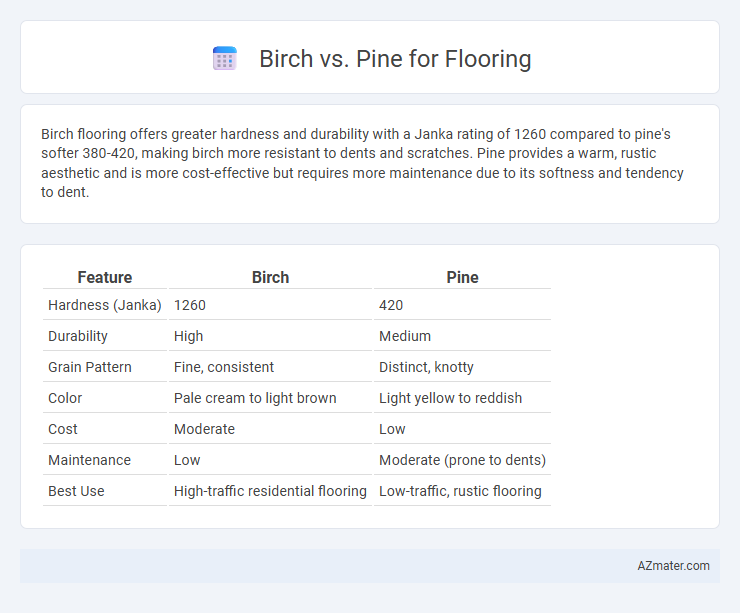Birch flooring offers greater hardness and durability with a Janka rating of 1260 compared to pine's softer 380-420, making birch more resistant to dents and scratches. Pine provides a warm, rustic aesthetic and is more cost-effective but requires more maintenance due to its softness and tendency to dent.
Table of Comparison
| Feature | Birch | Pine |
|---|---|---|
| Hardness (Janka) | 1260 | 420 |
| Durability | High | Medium |
| Grain Pattern | Fine, consistent | Distinct, knotty |
| Color | Pale cream to light brown | Light yellow to reddish |
| Cost | Moderate | Low |
| Maintenance | Low | Moderate (prone to dents) |
| Best Use | High-traffic residential flooring | Low-traffic, rustic flooring |
Introduction to Birch and Pine Flooring
Birch flooring offers a smooth texture with pale, creamy tones and tight grain patterns, making it an ideal choice for creating bright and modern interiors. Pine flooring features warm, rustic hues with distinctive knots and a softer texture that adds character and a vintage appeal to rooms. Both options provide durable hardwood solutions but differ in hardness and aesthetic, influencing their suitability for various design styles and wear resistance.
Key Differences Between Birch and Pine Wood
Birch wood is denser and harder than pine, making it more resistant to dents and scratches, which enhances its durability for flooring applications. Pine has a softer texture with more visible knots and a warmer, yellowish tone, while birch features a finer grain and a lighter, more uniform color that suits modern or sleek interior designs. Birch flooring typically demands higher maintenance due to its susceptibility to moisture, whereas pine offers easier refinishing but may require more frequent care to prevent surface wear.
Appearance and Grain Patterns
Birch flooring offers a fine, smooth grain with subtle, uniform patterns that create a warm and elegant appearance, often showcasing pale yellow to light reddish tones. Pine flooring features more prominent knots and a distinct, rustic grain pattern with wider growth rings, providing a cozy, natural charm typically in soft yellow to deep amber hues. Both woods vary in grain texture and color intensity, influencing the overall aesthetic and suitability for different interior design styles.
Durability and Hardness Comparison
Birch flooring offers superior hardness, typically rating between 1260 and 1300 on the Janka hardness scale, making it more resistant to dents and wear compared to pine, which scores around 380 to 870 depending on species. Pine's softness results in easier denting and scratching, requiring more maintenance in high-traffic areas. Birch's enhanced durability and hardness make it a preferred choice for long-lasting hardwood flooring installations.
Cost and Affordability
Birch flooring typically costs between $3 to $8 per square foot, making it a moderately priced option known for its durability and fine grain patterns. Pine flooring is generally more affordable, ranging from $2 to $5 per square foot, but it is softer and more prone to dents and scratches. Choosing between birch and pine depends on budget constraints and desired long-term wear, with pine appealing to cost-conscious projects and birch offering enhanced resilience at a higher price point.
Installation and Maintenance
Birch flooring offers a smooth, uniform texture that simplifies installation due to its consistent grain pattern, making it ideal for DIY projects and professional fitting. Pine, being softer and more prone to dents, requires careful handling during installation and periodic maintenance such as refinishing to preserve its appearance. Both wood types benefit from regular sweeping and moisture control, but birch's hardness generally results in reduced upkeep demands compared to pine.
Environmental Impact and Sustainability
Birch flooring offers a more sustainable option due to its faster growth rate and ability to regenerate quickly, reducing deforestation pressure compared to pine. Pine, often harvested from slower-growing trees in older forests, can contribute to habitat disruption and longer ecosystem recovery times. Both woods can be sourced responsibly with certifications like FSC, but birch's shorter harvest cycle typically results in a lower environmental impact and enhanced sustainability for flooring projects.
Best Uses for Birch Flooring
Birch flooring is ideal for high-traffic residential areas due to its durability and fine grain, providing a smooth, elegant finish that resists dents and wear. Its light color and uniform texture make it a popular choice for modern, Scandinavian, and minimalist interior designs, enhancing brightness and space perception. Birch works well in living rooms, hallways, and bedrooms where a combination of strength and aesthetic appeal is desired.
Best Uses for Pine Flooring
Pine flooring is ideal for rustic and country-style interiors due to its warm tones and natural knots that add character and charm. It performs best in low to moderate traffic areas like bedrooms and living rooms where its softer wood can withstand less wear and tear. Pine's affordability and ease of installation make it a popular choice for budget-conscious homeowners seeking a classic, timeless look.
Birch vs Pine: Which Is Right for Your Home?
Birch flooring offers a hard, durable surface with fine, consistent grain patterns that resist dents and scratches, making it ideal for high-traffic areas. Pine provides a softer, warmer aesthetic with natural knots and color variations but is more prone to dents and wear, suitable for low-traffic rooms or rustic designs. Choosing between birch and pine depends on the desired durability, appearance, and the room's usage intensity in your home.

Infographic: Birch vs Pine for Flooring
 azmater.com
azmater.com